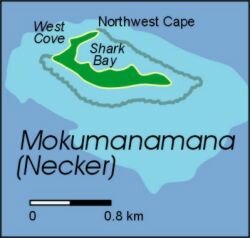About 155 miles northwest of Nihoa lies Mokumanamana, or Necker Island, a small basalt island that is 1/6 square kilometers, or 46 acres, in size. Although the island is the second smallest of the NWHI, it has the second largest surrounding marine habitat (almost 385,000 acres). Large offshore areas include Shark Bay on the north side, West Cove and Northwest Cape as well as miles of shallow reef to the southeast.

Mokumanamana is known for its numerous wahi pana (storied places) and mea makamae (cultural objects). Fifty-five cultural places are known, of which 33 are religious, 17 are shelter caves, and 2 sites are of unknown function. These cultural sites are thought to date primarily before the habitation sites on Nihoa Island were abandoned in the eighteenth century.
Because the island is small, dry, and has little soil suitable for agriculture, Hawaiians probably traveled to Mokumanamana from Nihoa and other Hawaiian Islands primarily for religious purposes. In addition to constructing religious structures, Hawaiians made ki'i pöhaku or stone human images while on Mokumanamana. More than 11 of these stone ki'i are known. Other activities that took place on the island are indicated by the production and use of stone adzes, grindstones, stone bowls, and fishing tools.
In 1786 Compte de La Pérouse visited Mokumanamana and named it "Necker Island" after Jacques Necker, the finance minister under Louis XVI. In 1857, Kamehameha IV sent Captain John Paty to claim Mokumanamana for the Kingdom of Hawai`i. His claim was contested until 1894, when the island was annexed by Hawai`i's Provisional Government. The Tanager Expedition visited Mokumanamana in 1923-24 to conduct biological and cultural research. Members of the Native Hawaiian organization Hui Malama I Na Kupuna O Hawai`i Nei visited Mokumanamana in 1997 to rebury ancestral human bones that were removed from the island in the 1920s.
Terrestrial animal life on Mokumanamana includes the blue gray noddy, land snails, wolf spiders, bird ticks, and 15 endemic insects. Marine life includes gray reef sharks and manta rays. Hawaiian monk seals are seen on the island's rocky shores. A great abundance and diversity of sea cucumbers, sea urchins, and lobsters are found in Shark Bay. Little coral life exists in the shallow areas due to the constant wave action that scours the underwater basalt. Most reef life is found in holes and elevated areas protected from the currents. Below the shallow reef are extensive deeper "shelves" that extend many miles from the island, especially to the southeast. These broad offshore areas are used for commercial fishing.
Visiting Mokumanamana is permitted only for scientific, educational and cultural purposes in order to protect its significant natural and cultural resources. Approval must be given by the U.S. Fish and Wildlife Service and is mostly granted to those doing cultural and scientific activities.
|

